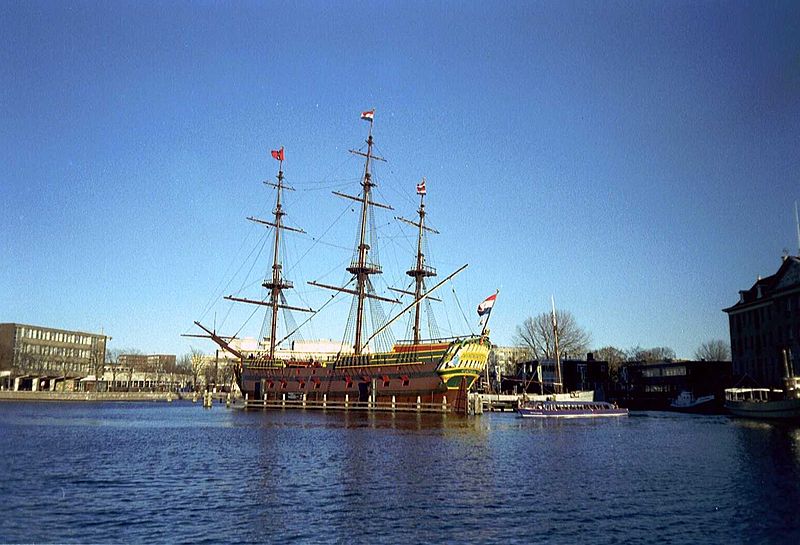http://www.abc.net.au/news/2015-02-03/unearthed-grave-sheds-light-on-batavia-shipwreck-mass-murder/6068008
American Admiralty Books Safety & Privacy Policies |
| The Amsterdam is a three-masted full-rigged VOC ship, launched in 1748, sunk in 1749; now a maritime museum in the port of Amsterdam. Photo Credit:/Gebruiker:Wolke GNU Free Documentation License |
On June 4, 1629 a Dutch merchant vessel veered off course and was grounded and eventually sunk off the Abrolhos Islands near Australia. During the early failed salvage attempt 180 people including "30 women and children" were ferried ashore to an uninhabited island while 70 plus men remained aboard working the damage control,and re-floating effort.
The survivors are believed to have landed on Beacon Island, which did not have the fresh water and food sources to sustain a population as large as was finally landed when all efforts to salvage the ship failed.
Once it was clear that all could not survice for any serious;y protracted period on the salvaged provisions from the ship an expedition was launched in one of the ship's long boats to seek help. The ship's captain and a number of seamen set off in the long boat to see help from dutch authorities on Java. "Undermerchant" (similar to "Purser") Jeronimus Cornelisz assumed charge of the group left on Beacon Island. He began reducing the population by sending off survivors in search of fresh water on near by islands, trips he anticipated they would not survive. Later, his men followed the simple expedient of drowning others. He had women, children, the ill and infirm killed. He kept his cut throat crew loyal by keeping a number of women alive subject to repeated rape.
Eventually there was the inevitable revolt and Cornelisz was captured by men he had sent to one of the near by islands. But when the Captain of the ship returned he viewed the non crew members as mutineers. He had the right hands of the direct "mutineers" chopped off, then constructed a gallows and hanged the lot. Some of the "lesser offenders were returned to Holland, while two men were marooned on the island as punishment.
It is interesting to note that this was a merchant vessel and the law exacted these horrific penalties was simply contract law. This is perhaps one of the worst examples of "governing like a business", this was government by a business the various East India Companies would repeat such episodes many times in the Far East.
Recent discovery of some of the bodies and artifacts from this episode of Australian history have recently been studies and an archaeological excavation is under way. You can read more about it and see photos at ABC NEWS : "Unearthed grave sheds light on Batavia shipwreck mass murder". Note that today the headline calls the event mass murder. When it happened it was regarded by the Dutch government as simply a properly settled labor dispute ( relative to crew) and customer dispute ( relative to passengers).
No comments:
Post a Comment